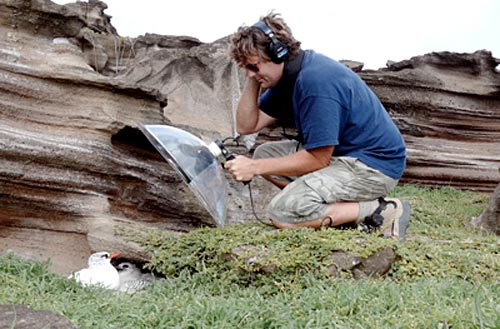Field Report: Birds That Sound Like Kazoos
By Jon Erickson
January 28, 2010
Here’s part two of Jon Erickson’s report from his holiday visit to Round Island, 14 miles off Mauritius in the Indian Ocean:
Evenings on Round Island are quite special. The island is home to a large colony of Wedge-tailed Shearwaters that dig burrows into the loose soil to lay their eggs. After the sun goes down, the wedge-tails begin returning to the island in massive numbers and soon afterward they begin making their wonderful call.
Hear the “kazoo opera” sound of the Wedge-tailed Shearwater:
The best way to describe the call is to imagine a group of thousands of birds with kazoos taped to their bills. It is quite comical and I spent a good part of my first night laughing to myself in my tent. In fact, I got very little sleep for my entire two weeks on the island because of these birds. Not because they woke me up, but because I was recording the sounds from inside my tent with a long cable and a pair of stereo microphones outside.
The shearwaters are not as graceful as the petrels I wrote about last week. When scared, they take to the air no matter what’s in front of them, be it a wall, a tree, or, on one unfortunate evening, my face. There were so many around that they continually fell into the footing holes I was digging for the storage shed. Eventually I was forced to cover the holes, even while I was working nearby.
Watch me helping a shearwater back out of the hole:
I also got to help warden Tom with his weekly searches for keel-scaled boas, large nocturnal snakes found only on Round Island. This meant hiking in the dark across a rocky island shaped like a volcano sliced vertically down the middle. One search took us down into the central crater. With waves crashing below us and a full moon above us, we walked six feet apart looking for snakes and any other reptiles. Just at the end of our search, in the farthest corner of the quadrant, we found a large boa and Tom grabbed it. He handed it to me to hold as he measured and tagged it. The snake was beautiful as it wrapped its four-foot body around my arm. After searching for its tag we realized that this snake had never been captured before. We were probably the first people to ever see this particular individual.
My two weeks on Round Island passed quickly catching petrels, searching for boas, giving water to giant tortoises (Aldabran tortoises have been brought here as on Ile aux Aigrettes), and building the storage shed. I accrued a massive collection of recordings: Herald Petrels (listen to it here), Wedge-tailed Shearwaters, Red-tailed and White-tailed tropicbirds, and even an accidental Black-winged Petrel, normally seen in the Pacific rather than the Indian Ocean. I had also had the chance to become intimate with some very rare and special species.
By the time I was waiting nervously on the landing rock for our return boat trip, I was already getting excited for my scheduled return to the island in mid-January. I hope to amass even more recordings and look forward to falling asleep to the birds with kazoos taped to their bills.

All About Birds
is a free resource
Available for everyone,
funded by donors like you
American Kestrel by Blair Dudeck / Macaulay Library
